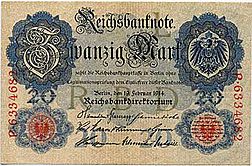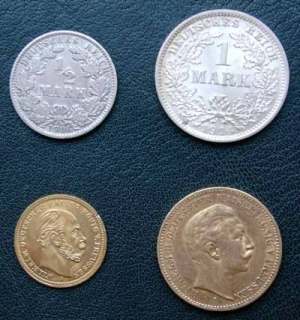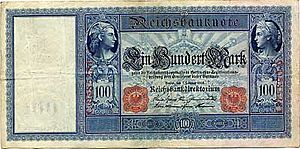German mark (1871) facts for kids
Quick facts for kids German mark (1871) |
|||
|---|---|---|---|
|
|||
| User(s) | German colonial empire |
||
| Subunit | |||
| 1⁄100 | Pfennig | ||
| Symbol | ℳ︁ | ||
| Pfennig | ₰ | ||
| Plural | Mark | ||
| Pfennig | Pfennig | ||
| Coins | 1, 2, 5, 10, 20, 25 Pfennig 1⁄2, 1, 2, 3, 5, 10, 20 Mark |
||
| Banknotes | 5, 10, 20, 50, 100, 1000 Mark | ||
The German mark (called Goldmark in German) was the money used in the German Empire. This empire existed from 1871 to 1918. The mark had a special symbol: ℳ︁.
One Mark was divided into 100 smaller coins called Pfennigs (symbol: ₰). From 1871 to 1914, the Mark was based on the gold standard. This meant its value was directly linked to a certain amount of gold. However, during World War I, Germany stopped linking its money to gold in August 1914. After that, gold coins were no longer used in everyday life.
After the German Empire ended in 1918, a new government called the Weimar Republic took over. They used a new type of mark, which people jokingly called the Papiermark (Paper Mark). This was because Germany faced extreme inflation from 1918 to 1923. This made the paper money almost worthless.
Contents
History of the German Mark
The German Mark was first introduced in 1873. This was a big step after many years of trying to create one single money system for all the different states in the German Confederation. Before the Mark, many different currencies were used across Germany.
Unifying German Money
In 1838, a group of German states called the Zollverein started to unify their money. They set a fixed value between the Prussian and South German currencies. Later, in 1857, a new coin called the Vereinsthaler was introduced. This coin helped link even more currencies together.
When Germany became one country in 1871, it was time for a single national currency. Leaders also wanted to switch to the gold standard. This meant that the value of money would be based on gold, making it more stable.
The Gold Standard and French Gold
A new unit, the mark, was proposed. It was designed to be easily divided into 100 pfennigs. The new mark was linked to a specific amount of gold. Germany got a lot of gold (about 4.05 billion gold marks) from France after the Franco-Prussian War ended in 1871. This gold helped launch the new currency in 1873.
The first Mark coins were gold 10-mark and 20-mark coins. There were also silver marks and copper pfennigs. Germany's move to the gold standard encouraged other countries in Europe and North America to do the same.
Even though the old Vereinsthaler was a silver coin, it could still be used as money for a while. It was worth 3 gold marks until 1908. Other old currencies were also converted to the new Mark at different rates.
From January 1, 1876, the Mark and the Vereinsthaler became the only official money in Germany. Before 1914, 2790 marks were equal to 1 kilogram of pure gold. This means one mark was worth about 0.358 grams of gold. The name Goldmark was used later to tell it apart from the Papiermark (paper mark). The Papiermark lost a lot of its value due to hyperinflation after World War I.
War Reparations and Debts
After World War I, Germany had to pay reparations (payments for damages) to the winning countries. These payments were set in gold marks. This was because the winning countries worried Germany might try to pay with worthless paper money.
Germany was supposed to pay 50 billion gold marks. From 1920 to 1931, Germany paid about 20 billion gold marks. Much of this money came from loans from American banks.
When the Nazis came to power in 1933, they stopped paying reparations. After World War II, West Germany did not restart reparation payments. However, it did pay back the loans Germany had taken out to pay reparations. The main part of these debts was paid by 1980. The interest on these debts was finally paid off on October 3, 2010, which was 20 years after Germany became unified again.
Coins of the German Mark
Coins from 1 pfennig to 1 mark had standard designs for the whole German Empire. However, coins worth more than 1 mark were made by individual German states. These larger coins usually had the German Empire's eagle on one side. The other side showed a picture specific to that state, often a portrait of its ruler. Free cities like Bremen, Hamburg, and Lübeck used their city's coat of arms.
Sometimes, special commemorative coins were made to celebrate events. Many smaller states made very few coins. Also, after World War I began, fewer coins were made by all states. Well-preserved coins from states that made very few can be rare and valuable today.
Base Metal Coins
These coins were made from less valuable metals:
- 1 pfennig: Made of copper from 1873–1916, then aluminium from 1916–1918.
- 2 pfennig: Made of copper from 1873–1916.
- 5 pfennig: Made of cupro-nickel from 1873–1915, then iron from 1915–1922.
- 10 pfennig: Made of cupro-nickel from 1873–1916, then iron and zinc from 1915–1922.
- 20 pfennig: Made of cupro-nickel from 1887–1892.
- 25 pfennig: Made of nickel from 1909–1912.
Silver Coins
Silver coins were made with 90% pure silver. Each mark in silver coins contained 5 grams of silver.
- Production of 2 and 5 mark coins stopped in 1915.
- 1-mark coins continued until 1916.
- A few 3-mark coins were made until 1918.
- 1⁄2 mark coins (50 pfennig) were made in silver until 1919.
Here are the silver coin values:
- 20 pfennig (1 gram silver), made only until 1878.
- 1⁄2 mark or 50 pfennig (2.5 grams silver).
- 1 mark (5 grams silver).
- 2 mark (10 grams silver).
- 3 mark (15 grams silver), made from 1908 onwards.
- 5 mark (25 grams silver).
These silver coins were considered "token" money for the gold mark. This means they were only legal for payments up to 20 marks. However, older silver 3-mark Vereinsthaler coins made before 1871 could be used for any amount. This changed in 1908 when the Vereinsthaler was no longer official money.
Gold Coins
Gold coins were made with 90% pure gold. The standard was that 2790 marks were equal to 1 kilogram of gold. This means one mark was worth about 0.3584 grams of gold. Gold coin production stopped in 1915.
- 5 mark gold coins were only made in 1877 and 1878.
- 10 mark gold coins.
- 20 mark gold coins.
Gold marks are popular with coin collectors. The 20-mark coin is the most common and comes in many types. Some designs are very rare because only a few were made. For example, a 20-mark coin featuring Adolph Friedrich V is extremely rare, with only 1,160 pieces ever made.
Banknotes
Paper money was issued by the Imperial Treasury (called "Reichskassenschein") and the Reichsbank (the central bank). Some individual German states also issued their own banknotes.
- Imperial Treasury notes came in values of 5, 10, 20, and 50 Mark.
- Reichsbank notes were made in values of 20, 50, 100, and 1000 Mark.
The banknotes issued after 1914 are known as the Papiermark.
Currency Signs
In computer systems, the Mark sign is represented as Error using : Input "2133" is not a hexadecimal value.. The Pfennig sign is Error using : Input "20b0" is not a hexadecimal value..
See also
 In Spanish: Marco de oro alemán para niños
In Spanish: Marco de oro alemán para niños






